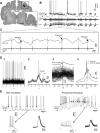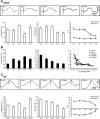Synaptic strength modulation after cortical trauma: a role in epileptogenesis
- PMID: 18596152
- PMCID: PMC6670971
- DOI: 10.1523/JNEUROSCI.0643-08.2008
Synaptic strength modulation after cortical trauma: a role in epileptogenesis
Abstract
Traumatic brain injuries are often followed by abnormal hyperexcitability, leading to acute seizures and epilepsy. Previous studies documented the rewiring capacity of neocortical neurons in response to various cortical and subcortical lesions. However, little information is available on the functional consequences of these anatomical changes after cortical trauma and the adaptation of synaptic connectivity to a decreased input produced by chronic deafferentation. In this study, we recorded intracellular (IC) activities of cortical neurons simultaneously with extracellular (EC) unit activities and field potentials of neighboring cells in cat cortex, after a large transection of the white matter underneath the suprasylvian gyrus, in acute and chronic conditions (at 2, 4, and 6 weeks) in ketamine-xylazine-anesthetized cats. Using EC spikes to compute the spike-triggered averages of IC membrane potential, we found an increased connection probability and efficacy between cortical neurons weeks after cortical trauma. Inhibitory interactions showed no significant changes in the traumatized cortex compared with control. The increased synaptic efficacy was accompanied by enhanced input resistance and intrinsic excitability of cortical neurons, as well as by increased duration of silent network periods. Our electrophysiological data revealed functional consequences of previously reported anatomical changes in the injured cortex. We suggest that homeostatic synaptic plasticity compensating the decreased activity in the undercut cortex leads to an uncontrollable cortical hyperexcitability and seizure generation.
Figures








Comment in
-
Is modulation of cortical synapses after brain trauma homeostatic? Or, since when is epilepsy normal?Epilepsy Curr. 2009 Mar-Apr;9(2):53-4. doi: 10.1111/j.1535-7511.2008.01290.x. Epilepsy Curr. 2009. PMID: 19421381 Free PMC article. No abstract available.
Similar articles
-
Hyperexcitability of intact neurons underlies acute development of trauma-related electrographic seizures in cats in vivo.Eur J Neurosci. 2003 Aug;18(3):486-96. doi: 10.1046/j.1460-9568.2003.02742.x. Eur J Neurosci. 2003. PMID: 12911745
-
Acute injury to superficial cortex leads to a decrease in synaptic inhibition and increase in excitation in neocortical layer V pyramidal cells.J Neurophysiol. 2007 Jan;97(1):178-87. doi: 10.1152/jn.01374.2005. Epub 2006 Sep 20. J Neurophysiol. 2007. PMID: 16987927
-
Changes in long-range connectivity and neuronal reorganization in partial cortical deafferentation model of epileptogenesis.Neuroscience. 2015 Jan 22;284:153-164. doi: 10.1016/j.neuroscience.2014.09.079. Epub 2014 Oct 7. Neuroscience. 2015. PMID: 25304932 Free PMC article.
-
Posttraumatic epilepsy: the roles of synaptic plasticity.Neuroscientist. 2010 Feb;16(1):19-27. doi: 10.1177/1073858409333545. Epub 2009 Apr 9. Neuroscientist. 2010. PMID: 19359668 Free PMC article. Review.
-
Cellular abnormalities and synaptic plasticity in seizure disorders of the immature nervous system.Ment Retard Dev Disabil Res Rev. 2000;6(4):258-67. doi: 10.1002/1098-2779(2000)6:4<258::AID-MRDD5>3.0.CO;2-H. Ment Retard Dev Disabil Res Rev. 2000. PMID: 11107191 Review.
Cited by
-
Age dependency of trauma-induced neocortical epileptogenesis.Front Cell Neurosci. 2013 Sep 18;7:154. doi: 10.3389/fncel.2013.00154. eCollection 2013. Front Cell Neurosci. 2013. PMID: 24065884 Free PMC article.
-
Is modulation of cortical synapses after brain trauma homeostatic? Or, since when is epilepsy normal?Epilepsy Curr. 2009 Mar-Apr;9(2):53-4. doi: 10.1111/j.1535-7511.2008.01290.x. Epilepsy Curr. 2009. PMID: 19421381 Free PMC article. No abstract available.
-
Network reconfiguration and neuronal plasticity in rhythm-generating networks.Integr Comp Biol. 2011 Dec;51(6):856-68. doi: 10.1093/icb/icr099. Epub 2011 Aug 19. Integr Comp Biol. 2011. PMID: 21856733 Free PMC article. Review.
-
Homeostatic structural plasticity can account for topology changes following deafferentation and focal stroke.Front Neuroanat. 2014 Oct 16;8:115. doi: 10.3389/fnana.2014.00115. eCollection 2014. Front Neuroanat. 2014. PMID: 25360087 Free PMC article.
-
Repetitive Mild Traumatic Brain Injury in Rats Impairs Cognition, Enhances Prefrontal Cortex Neuronal Activity, and Reduces Pre-synaptic Mitochondrial Function.Front Cell Neurosci. 2021 Aug 10;15:689334. doi: 10.3389/fncel.2021.689334. eCollection 2021. Front Cell Neurosci. 2021. PMID: 34447298 Free PMC article.
References
-
- Abbott LF, Nelson SB. Synaptic plasticity: taming the beast. Nat Neurosci. 2000;3(Suppl):1178–1183. - PubMed
-
- Avramescu S, Timofeev I. Synaptic synchrony modulation following cortical injury. Soc Neurosci Abstr. 2006;32:235–26.
-
- Bausch SB, He S, Petrova Y, Wang XM, McNamara JO. Plasticity of both excitatory and inhibitory synapses is associated with seizures induced by removal of chronic blockade of activity in cultured hippocampus. J Neurophysiol. 2006;96:2151–2167. - PubMed
-
- Bladin CF, Alexandrov AV, Bellavance A, Bornstein N, Chambers B, Cote R, Lebrun L, Pirisi A, Norris JW. Seizures after stroke: a prospective multicenter study. Arch Neurol. 2000;57:1617–1622. - PubMed
Publication types
MeSH terms
LinkOut - more resources
Full Text Sources
Medical
Miscellaneous
